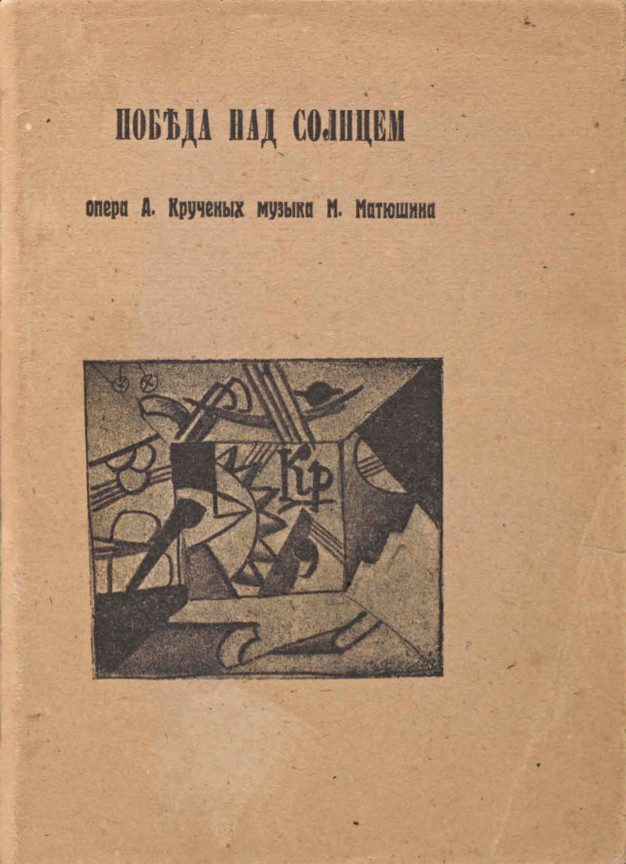Alexei Kruchenykh, et al.: Victory Over the Sun (1912–) [RU, EN, DE]
Filed under booklet | Tags: · avant-garde, futurism, music, opera, russia, theatre

“Victory over the Sun (Победа над Cолнцем; Pobeda nad Solntsem) is a Russian Futurist opera premiered in 1913 at the Luna Park in Saint Petersburg.
The libretto written in zaum language was contributed by Alexei Kruchenykh, the music was written by Mikhail Matyushin, the prologue was added by Velimir Khlebnikov, and the stage designer was Kazimir Malevich. The performance was organized by the artistic group Soyuz Molodyozhi. The opera has become famous as the event where Malevich made his first Black Square painting (in 1915).
The opera was intended to underline parallels between literary text, musical score, and the art of painting, and featured a cast of such extravagant characters as Nero and Caligula in the Same Person, Traveller through All the Ages, Telephone Talker, The New Ones, etc.
The audience reacted negatively and even violently to the performance, as have some subsequent critics and historians.” (Wikipedia)
Published in Moscow, Dec 1912
28 pages
English translation
Translated by Ewa Bartos and Victoria Nes Kirby
Published in The Drama Review 15:4, Fall 1971, pp 106-124
Kruchenykh at Monoskop wiki
Wikipedia
Pobeda nad solntsem (Russian, JPGs)
Victory Over the Sun (English, 1971)
Sieg über die Sonne (German, trans. & comm. Gisela Erbslöh, 1976, JPGs/PDF, added on 2015-8-10)
Audio recording (Monoskop wiki)
Comment (0)Bruce Nauman: Please Pay Attention Please: Bruce Nauman’s Words: Writings and Interviews (2003)
Filed under book | Tags: · art, conceptual art, electronic art, performance art, photography, sculpture

Since the 1960s, the artist Bruce Nauman has developed a highly complex and pluralistic oeuvre ranging from discrete sculpture, performance, film, video, and text-based works to elaborate multipart installations incorporating sound, video recording and monitors, and architectural structures. Nauman’s work is often interpreted in terms of movements and mediums, including performance, postminimalism, process, and conceptual art, thereby emphasizing its apparent eclecticism. But what is often overlooked is that underlying these seemingly disparate artistic tendencies are conceptual continuities, one of which is an investigation of the nature of language.
Unlike many of his contemporaries, Nauman has refrained from participating in the critical discourse surrounding his own work. He has given relatively few interviews over the course of his career and has little to do with the art press or critical establishment. Indeed, he granted Janet Kraynak and The MIT Press almost complete autonomy in the preparation of this volume. In contrast to Nauman?s reputation for silence, however, from the beginning of his career, the incorporation of language has been a central feature of his art. This collection takes as its starting point the seeming paradox of an artist of so few words who produces an art of so many words.
Please Pay Attention Please contains all of Nauman’s major interviews from 1965 to 2001, as well as a comprehensive body of his writings, including instructions and proposal texts, dialogues transcribed from audio-video works, and prose texts written specifically for installation sculptures. Where relevant, the texts are accompanied by illustrations of the artworks for which they were composed. In the critical essay that serves as the book’s introduction, the editor investigates Nauman’s art in relation to the linguistic turn in art practices of the 1960s—understanding language through the speech act—and its legacy in contemporary art.
Edited by Janet Kraynak
Publisher MIT Press, 2003
Writing Art series
ISBN 0262140829, 9780262140829
426 pages
Bob Snyder: Music and Memory: An Introduction (2001)
Filed under book | Tags: · cognition, memory, music, sound recording

This far-ranging book shows how human memory influences the organization of music. The book is divided into two parts. The first part presents basic ideas about memory and perception from cognitive psychology and, to some extent, cognitive linguistics. Topics include auditory processing, perception, and recognition. The second part describes in detail how the concepts from the first part are exemplified in music. The presentation is based on three levels of musical experience: event fusion (the formation of single musical events from acoustical vibrations in the air, on a time scale too small to exhibit rhythm), melody and rhythm, and form. The focus in the latter is on the psychological conditions necessary for making large-scale—that is, formal—boundaries clear in music rather than on traditional musical forms. The book also discusses the idea that much of the language used to describe musical structures and processes is metaphorical. It encourages readers to consider the possibility that the process of musical composition can be “a metaphorical transformation of their own experience into sound.”
The book also touches on unresolved debates about psychological musical universals, information theory, and the operation of neurons. It requires no formal musical training and contains a glossary and an appendix of listening examples.
Publisher MIT Press, 2001
ISBN 0262692376, 9780262692373
313 pages

